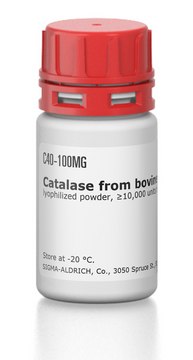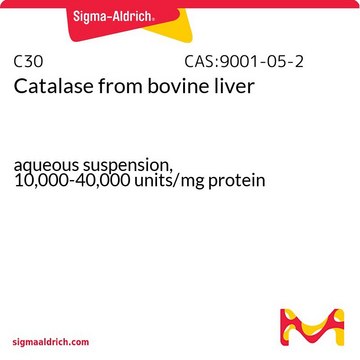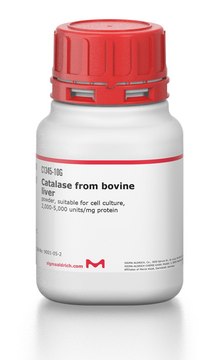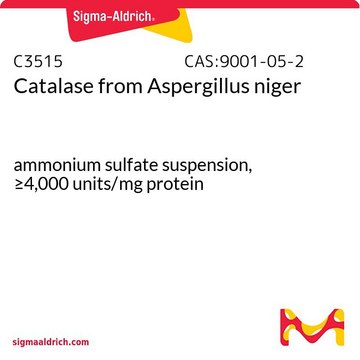G0543
Glucose Oxidase from Aspergillus niger
≤0.1 units/mg protein catalase, buffered aqueous solution, pH 4.5, low catalase activity
Synonym(s):
β-D-Glucose:oxygen 1-oxidoreductase, G.Od., GOx
Sign Into View Organizational & Contract Pricing
All Photos(1)
About This Item
CAS Number:
MDL number:
UNSPSC Code:
12352204
Recommended Products
form
buffered aqueous solution
specific activity
≥200 units/mg protein
mol wt
160 kDa
composition
, ≥15 mg/mL
impurities
≤0.1 units/mg protein catalase
pH
4.5
storage temp.
2-8°C
InChI
1S/C6H12O6/c7-1-2-3(8)4(9)5(10)6(11)12-2/h2-11H,1H2/t2-,3-,4+,5-,6-/m1/s1
InChI key
WQZGKKKJIJFFOK-VFUOTHLCSA-N
Looking for similar products? Visit Product Comparison Guide
General description
Molecular Weight: 160 kDa (gel filtration)
pI: 4.2
Extinction coefficient: E1% = 16.7 (280 nm)
Glucose oxidase from Aspergillus niger is a dimer consisting of 2 equal subunits with a molecular mass of 80 kDa each. Each subunit contains one flavin adenine dinulceotide moiety and one iron. The enzyme is a glycoprotein containing ~16% neutral sugar and 2% amino sugars. The enzyme also contains 3 cysteine residues and 8 potential sites for N-linked glycosylation.
Glucose oxidase is capable of oxidizing D-aldohexoses, monodeoxy-D-glucoses, and methyl-D-glucoses at varying rates.
The pH optimum for glucose oxidase is 5.5, while it has a broad activity range of pH 4-7. Glucose oxidase is specific for β-D-glucose with a KM of 33-110 mM.
Glucose oxidase does not require any activators, but it is inhibited by Ag+, Hg2+, Cu2+, phenylmercuric acetate, and p-chloromercuribenzoate. It is not inhibited by the nonmetallic SH reagents: N-ethylmaleimide, iodoacetate, and iodoacetamide.
Glucose oxidase can be utilized in the enzymatic determination of D-glucose in solution. As glucose oxidase oxidizes β-D-glucose to D-gluconolactate and hydrogen peroxide, horseradish peroxidase is often used as the coupling enzyme for glucose determination. Although glucose oxidase is specific for β-D-glucose, solutions of D-glucose can be quantified as α-D-glucose will mutorotate to β-D-glucose as the β-D-glucose is consumed by the enzymatic reaction.
pI: 4.2
Extinction coefficient: E1% = 16.7 (280 nm)
Glucose oxidase from Aspergillus niger is a dimer consisting of 2 equal subunits with a molecular mass of 80 kDa each. Each subunit contains one flavin adenine dinulceotide moiety and one iron. The enzyme is a glycoprotein containing ~16% neutral sugar and 2% amino sugars. The enzyme also contains 3 cysteine residues and 8 potential sites for N-linked glycosylation.
Glucose oxidase is capable of oxidizing D-aldohexoses, monodeoxy-D-glucoses, and methyl-D-glucoses at varying rates.
The pH optimum for glucose oxidase is 5.5, while it has a broad activity range of pH 4-7. Glucose oxidase is specific for β-D-glucose with a KM of 33-110 mM.
Glucose oxidase does not require any activators, but it is inhibited by Ag+, Hg2+, Cu2+, phenylmercuric acetate, and p-chloromercuribenzoate. It is not inhibited by the nonmetallic SH reagents: N-ethylmaleimide, iodoacetate, and iodoacetamide.
Glucose oxidase can be utilized in the enzymatic determination of D-glucose in solution. As glucose oxidase oxidizes β-D-glucose to D-gluconolactate and hydrogen peroxide, horseradish peroxidase is often used as the coupling enzyme for glucose determination. Although glucose oxidase is specific for β-D-glucose, solutions of D-glucose can be quantified as α-D-glucose will mutorotate to β-D-glucose as the β-D-glucose is consumed by the enzymatic reaction.
Application
Glucose oxidase is widely used in the food and pharmaceutical industries as well as a major component of glucose biosensors.
Biochem/physiol Actions
Glucose oxidase catalyses the oxidation of β-d-glucose to d-glucono-β-lactone and hydrogen peroxide, with molecular oxygen as an electron acceptor.
Unit Definition
One unit will oxidize 1.0 μmole of β-D-glucose to D-gluconolactone and H2O2 per min at pH 5.1 at 35 °C, equivalent to an O2 uptake of 22.4 μl per min. If the reaction mixture is saturated with oxygen, the activity may increase by up to 100%.
Physical form
Solution in 50 mM potassium phosphate, 100 mM sodium acetate, 250 mM KCl, with 0.004% thimerosal, pH 4.5.
Disclaimer
For U.S. Customers: Contains mercury; Do not place in trash - dispose according to local, state, or federal laws.


Signal Word
Danger
Hazard Statements
Precautionary Statements
Hazard Classifications
Resp. Sens. 1
Storage Class Code
12 - Non Combustible Liquids
WGK
WGK 1
Flash Point(F)
Not applicable
Flash Point(C)
Not applicable
Personal Protective Equipment
dust mask type N95 (US), Eyeshields, Gloves
Regulatory Information
常规特殊物品
Choose from one of the most recent versions:
Already Own This Product?
Find documentation for the products that you have recently purchased in the Document Library.
Matthew S Graus et al.
Cell reports, 24(9), 2432-2442 (2018-08-30)
Cell wall mannans of Candida albicans mask β-(1,3)-glucan from recognition by Dectin-1, contributing to innate immune evasion. Glucan exposures are predominantly single receptor-ligand interaction sites of nanoscale dimensions. Candida species vary in basal glucan exposure and molecular complexity of mannans.
Jonathan D Hakim et al.
Behavioural brain research, 381, 112416-112416 (2019-12-15)
Functional-anatomical changes in reward related brain circuits are described in chronic pain patients who report anhedonia or depressed mood. In pre-clinical rodent models of neuropathic pain there are varying reports of the effects of nerve injury on the motivation to
Susan Duncan et al.
Bio-protocol, 7(8), e2240-e2240 (2017-04-20)
Methods that allow the study of gene expression regulation are continually advancing. Here, we present an in situ hybridization protocol capable of detecting individual mRNA molecules in plant root cells, thus permitting the accurate quantification and localization of mRNA within
Jia Lin et al.
Molecular biology of the cell, 27(6), 1002-1014 (2016-01-23)
The cell wall of Candida albicans is composed largely of polysaccharides. Here we focus on β-glucan, an immunogenic cell-wall polysaccharide whose surface exposure is often restricted, or "masked," from immune recognition by Dectin-1 on dendritic cells (DCs) and other innate
Carol Ho-Yan Fong et al.
iScience, 25(4), 104037-104037 (2022-03-26)
The mucosal antiviral role of type I and III interferon in influenza virus infection is well established. However, much less is known about the antiviral mechanism of type II interferon (interferon-gamma). Here, we revealed an antiviral mechanism of interferon-gamma by
Our team of scientists has experience in all areas of research including Life Science, Material Science, Chemical Synthesis, Chromatography, Analytical and many others.
Contact Technical Service







